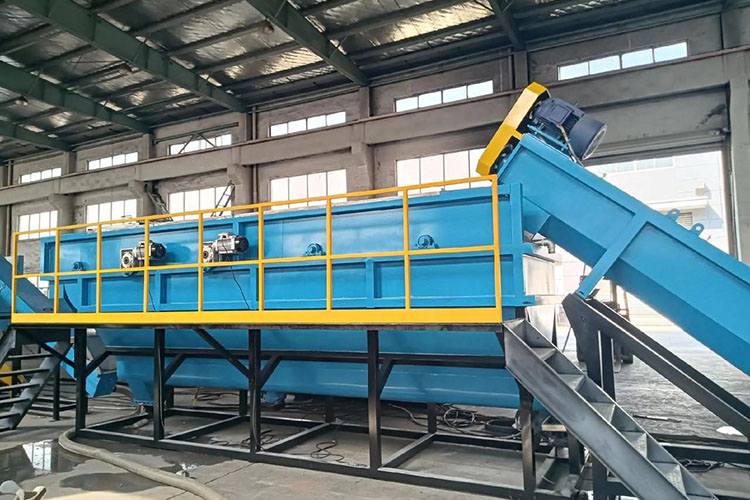HW49 hazardous waste refers to other wastes that are not explicitly covered by other categories, usually including discarded packaging, containers, cleaning debris, etc. that contain or are directly contaminated with hazardous waste. Due to its complex and diverse composition, special equipment and processes are required to treat these wastes to ensure the safety and effectiveness of treatment.
In the treatment of HW49 hazardous waste, crushing equipment is an indispensable first step. Many HW49 wastes are irregular in shape and large in size, so they need to be cut into smaller sizes by crushing equipment for subsequent treatment. For example, for discarded HDPE chemical barrels, a four-axis shredder is usually used for preliminary crushing. This equipment can efficiently handle hard plastics and reduce the processing difficulties caused by uneven material sizes.

After the initial crushing is completed, the cleaning equipment comes on the scene. The main purpose of cleaning is to remove residual substances on the surface of the waste, such as oil, chemicals, etc. Strong friction cleaning machines and rinsing sinks are common cleaning equipment. These equipment can greatly improve the cleaning efficiency by combining mechanical friction and water flushing, ensuring that the surface of the waste is clean and free of residue, providing reliable protection for subsequent treatment.
After cleaning, waste usually needs to be dehydrated and dried for storage or further processing. Dehydration and drying equipment plays an important role in this link. High-speed dehydrator is a representative equipment. It spins at high speed to dry the surface of waste. It is not only simple to operate but also highly efficient. At the same time, with hot air drying equipment, the moisture content of waste can be further reduced to meet the requirements of subsequent processes.
For some HW49 wastes that are difficult to degrade, thermal treatment equipment is a common treatment method. Through incinerators and other equipment, organic matter can be decomposed into harmless small molecules, or even directly converted into carbon dioxide and water. However, harmful gases such as dioxins may be produced during thermal treatment, so it is necessary to equip complete tail gas purification equipment. Purification equipment includes high-efficiency dust removal devices, activated carbon adsorption systems, etc. to ensure that the exhaust gas meets environmental standards.

In addition, chemical treatment equipment also occupies an important position in HW49 waste treatment. Using chemical reactions, harmful substances can be converted into harmless substances. For example, adding chemical agents to the reactor to react with the waste can effectively decompose complex toxic components. Although the cost of chemical treatment is relatively high, it is highly adaptable and efficient, especially for certain types of hazardous waste.
In the field of environmental protection technology, biological treatment equipment has gradually emerged. By using specific microbial strains to degrade organic matter in waste in bioreactors, this method is not only green and environmentally friendly, but also effectively reduces secondary pollution. However, biological treatment has high requirements for environmental conditions, such as temperature, humidity and pH value, so a special control system is required to ensure the smooth progress of the treatment process.
When selecting appropriate equipment and process flow, the specific composition, quantity and hazard of HW49 waste must be considered comprehensively. At the same time, ensure that the operation process of the equipment complies with national and local environmental protection and safety regulations to avoid secondary pollution or other safety accidents caused by improper treatment.

In short, the treatment of HW49 hazardous waste is a complex and technically demanding task. Through the scientific and rational use of equipment such as crushing, cleaning, dehydration and drying, heat treatment, chemical treatment and biological treatment, the harmless treatment of HW49 waste can be effectively achieved. At the same time, throughout the treatment process, it is necessary to always adhere to the principles of green environmental protection and resource utilization to contribute to the construction of a sustainable society.
Yongle Environmental Protection is mainly engaged in the research and development, production and sales of complete sets of technical equipment for organic solid waste disposal and comprehensive utilization. Production and manufacturing, domestic waste treatment equipment, tire pyrolysis equipment, medical waste disposal equipment, hazardous waste disposal equipment, and achieve efficient and comprehensive utilization of resources through independently developed low-temperature anaerobic pyrolysis equipment technology solutions.
Tags:Detailed introduction of hw49 hazardous waste treatment equipment,hw49 hazardous waste treatment equipment,YONGLE GROUP
 Latest news
Latest news


























